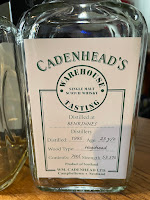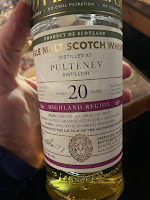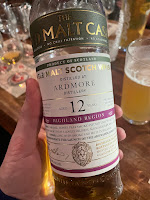 | ||||||||||||
| The full line-up (beer optional) Club chairman James was on hand to select and present a series of six drams from the oldest malt distillers in Scotland that are still going, for our September tasting.
As the name Tropically Total Taste suggested, this was very fruity. Sharp on the palate, with notes including pineapple, boiled sweets and pear drops. Not a long aftertaste, but nice and smooth, and those in the room who tried it with a bit of water said the whisky took it well, and took away a little spicy hint that some had noticed. I got a bit of sherbet too. A very good start to the night. It was 58.1% and at the time cost £83 with an SMWS membership.
Oban next and last year's bottling from Diageo's Special Releases range. Oban is both the oldest and the smallest distillery in Diageo's portfolio. Its history stretches to 1794 and modern celebrity fans include Bill Murray. This was a 10-year-old, matured in recharred oak and finished in oloroso sherry. This was sweet again, but more like toffee this time. It went on a lot longer on the palate for us. Honey was another common tasting note, and it was reminiscent of Scottish-style heather honey. Very nice all round. It was 58% and came in at £80.
Back to the SMWS for dram three and a Glen Garioch, one of the most mispronounced places in Scotland (It's GEAR-ee). It's a district of Aberdeenshire, based in and around Inverurie, with the distillery in nearby Oldmeldrum. It was the least old of the six distilleries, but still has a history dating to 1797. We had a 20-year-old aged in a first fill ex-bourbon barrel. "Great nose... classic taste" were some early descriptions of this one. Candyfloss and marshmallows put us in mind of the sweet shop again. But it was nutty and waxy on the mouth as welll, maybe a bit of almonds in there. Berries too, which fit in with the SMWS note of blackcurrants, although we didn't get as much of the cinnamon toast also advertised in the tasting description. Lots of people really enjoyed this, though, a lovely dram. It was 55.6% and we paid £120.
And it was a Glenturret, the oldest distillery of all going back to 1775. The bottle we had wasn't quite that old, but it was pretty elderly, a 28-year-old bottled back in 2015, with liquid dating from 1986. This cost us £250 at auction all in, but despite the age was still 51.8%. It was delicious. The bourbon cask used here helped to show off the whisky particularly well. There was something chocolatey about it, and coconut too, so inevitably we thought of a Bounty. Superb, then, but we did debate whether it was worth all that money. "If someone else is paying, then yes" was the general consensus.
This was very smooth. On the nose you wouldn't guess it was peaty really. But it comes through well enough on the palate. The finish was complex too: chocolate but also minty, like an After Eight. This was 50.4% and cost us £160.
There had plenty of peat on the nose. Barbecue and wood-fired flavours were to the fore. Very nice all round but the peatiness was the real high point. Those who tried it with a bit of water advised against it though. It was 55.7%. Which brought us to the dram of the night voting. Every whisky got at least two votes, perhaps the first time we've had quite such an even spread. But emerging from the pack was dram four, the Glenturret, with 12 votes. The opener from Strathisla was second, with the Bowmore third. They're all great tastings but this had some particularly well-chosen drams, so thank you to James for all the time and effort spent putting it together, and thanks to all club members for attending. |




















































